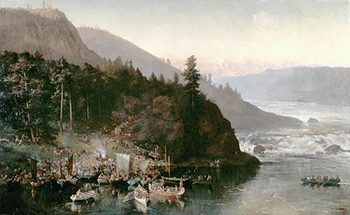The Red River Expedition of 1870 National Historic Event

Credit: Library and Archives Canada, Acc. No. 1989-400-1 In memory of Viscount Wolseley
In May 1870, Col. Garnet J. Wolseley led an expedition from Toronto, Ontario, to the Red River Settlement in what is now Manitoba to oversee the transfer of power from the provisional government, led by Louis Riel, to the Dominion of Canada. This was the last British military operation on North American soil. It served both international and domestic political purposes. As a firm display of Canadian sovereignty, it demonstrated to American expansionists that Canada intended, with Britain's support, to assert control over its new territorial acquisition, recently acquired from the Hudson's Bay Company. At the same time, its despatch appeased the anger of some Protestants in Ontario that had been aroused by the actions of the provisional government.
Under Wolseley's command were two militia battalions, the 1st (Ontario) Rifles and the 2nd (Quebec) Rifles, and one battalion of British regulars (373 officers and men from the 60th Rifles), plus small detachments from the Royal Artillery, the Royal Engineers, the Army Service Corps, and the Army Hospital Corps. In total, there were 1,214 officers and men. The troops travelled primarily by steamboat from Toronto to Port Arthur (Thunder Bay). An inland road from Lake Superior had not yet been completed. The 94-day journey overland across more than 1,100 km, was all the more strenuous with few roads, bridges, or supply depots to aid them. They finally arrived at Upper Fort Garry (Winnipeg), in a downpour, on 24 August 1870.
At this time, the Red River Settlement had 13,000 residents, the largest population west of Lake Superior. Approximately 90 percent of the residents were of mixed Indigenous and European ancestry, some of which were Métis. Many of their families had been living on these lands for generations. A provisional government, led by Louis Riel, had been formed in December 1869, and Ottawa directed that this provisional government was to remain in place until the summer of 1870, when administration of the settlement could be handed over to dominion authorities, including a new civilian lieutenant-governor. However, this new lieutenant-governor was delayed en route, and Wolseley's expedition arrived first. Riel and other leading members of the provisional government, not sure what to expect with the arrival of the troops at the settlement, vacated Upper Fort Garry shortly before Wolseley and his men arrived.
Anti-Riel sentiment in Ontario, spurred in part by the provisional government's execution of Thomas Scott, meant that Wolseley's military expedition was seen by many in that province as a way of putting the “rebels” in their place. Some of the members of the expedition, including Wolseley himself, expressed disappointment that Riel had left before they reached Upper Fort Garry. Once the expedition arrived in Manitoba, the absence of effective civil authority created a political and legal vacuum. A number of Métis became victims of verbal and physical altercations and assault, and most of the suspected wrongdoers were not punished, and those that were punished received only light sentences or fines. Many long-term residents of Red River felt considerable anxiety in this chaotic environment, and some Métis families liquidated their assets and moved beyond the reach of newcomers.
The British regulars soon returned to the East, but the militia regiments remained as a garrison for the new province of Manitoba. The difficult situation was not necessarily eliminated by disbanding the regiments in the summer of 1871. Many of the militiamen stayed in Manitoba, settling in the growing towns or staking out good farmland, some of which was already occupied by Métis families.
The National Program of Historical Commemoration relies on the participation of Canadians in the identification of places, events and persons of national historic significance. Any member of the public can nominate a topic for consideration by the Historic Sites and Monuments Board of Canada.
- Date modified :